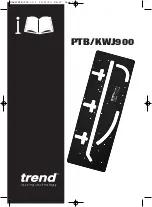
OPERATIONS
DEPTH-OF-CUT INDICATOR
The Depth-Of-Cut Indicator, located on the front of the machine, is a convenient way to
quickly determine how much material is being planed off in one pass.
1.
With the machine OFF, insert your workpiece just under the cut scale (A). SEE FIG 11
2.
Crank the raising / lowering handle until the button (B) comes in contact with the workpiece.
As you rotate the raise / lower handle, the needle on the depth of cut scale will move
showing how much material will be removed in that pass.
FIG. 11
GETTING PREPARED
It is always a good idea to use a piece of scrap wood for your first planing attempt. Also, before
each use of the planer, make it a habit of checking for loose fasteners, fittings or hardware. Turn
the planer ON and allow it to reach full speed. Pay close attention to any excessively loud
noises that may be coming from the planer or any excessive vibration. If either occurs, shut
down the planer immediately checking again for loose hardware. Go through the ASSEMBLY
and ADJUSTMENTS sections again if necessary.
BASIC OPERATION
WARNING!
To avoid serious personal injury, NEVER stand directly in line with the front or rear
of the planer. If an object is thrown from the planer, it will travel in this direction.
1.
Stand to either the left or right side of the planer.
2.
Turn the switch to the ON position.
3.
Lift the workpiece onto the infeed table by grabbing the edges of the board at the middle
of the length. NOTE: For longer pieces, be sure to use additional supports or stands.
3.
Push slightly on the board to start feed and allow the feed rollers to pull the board through
the planer. Once the feed rollers start to pull the workpiece through, let go of the board and
allow the rollers to do their job. DO NOT push or pull on the workpiece once the rollers
have engaged.
4.
Move to one side of the rear of the planer and receive the planed workpiece by grabbing the
edges of the wood like you did when feeding the workpiece in.
6.
It normally takes several passes of varying depths to achieve a smooth finish, so repeat
this process as many times as necessary. Remember the less you take off in a pass, the
smoother the finish will be. Finish the surface by sanding.
19









































